Last updated: January 7, 2023
Article
Who Wears the Pants Around Here?
After a promising start in the early 1920s, only a handful of women were hired as park rangers and naturalists in the late 1920s and early 1930s. Carlsbad Caverns National Park and the national monuments of the Southwest became the new hot spots for women in uniformed positions in the 1930s. In 1933, military parks in the East were added to the NPS, providing new opportunities for women to work as archeologists, historians, and museum aids in more populated areas.
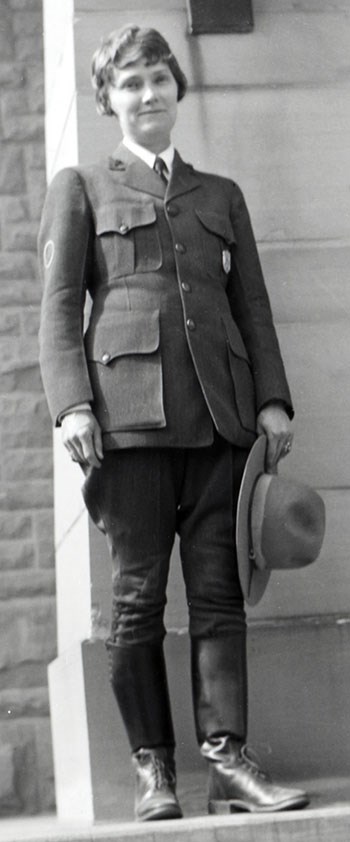
A One-Two Punch
Although deliberate efforts in the late 1920s and early 1930s to exclude them were blows to women who wanted to be rangers and naturalists in the NPS, it was arguably the Great Depression that put the early promise for women in these positions on the ropes.
As the Depression worsened, the Economy Act of 1932 was passed. Section 213 of the law contained two provisions that affected married people working for the government. One reduced the number of federal jobs available, while the second meant that only half of a married couple could work for the government.
Although the law made it clear that either the husband or the wife could be retained, in the NPS the women with temporary jobs were the obvious reduction over their husbands with permanent ones. It was a decision the women no doubt agreed with at that difficult time. For Herma Albertson Baggley and her husband George, the choice was perhaps starker as they both had permanent positions. Her personnel file lists the reason for her resignation in 1933 as “to become a full-time homemaker” but one has to wonder if these larger national events also played into her choice.
Although many women left the NPS at this time, the Great Depression also brought some women to it the first time. Business college graduate Ardra Tarbell began her career with the NPS as a clerk at Acadia National Park on April 29, 1930. In an oral history interview she cited the October 1929 crash as the reason she “gambled” on a six-month appointment as a clerk at the park. She retired as the park’s administrative officer 40 years later.
Special hiring authorities also gave some women short-term jobs. Florence E. Taylor got a ranger-naturalist position at Yosemite National Park, although it only amounted to six weeks in July and October 1930. Thelma McKinnon was hired as a temporary “museum caretaker” at Sequoia National Park from June to August 1930. She was rehired on June 1 the next year but resigned at the end of that month.
Government emergency relief programs, such the Works Progress Administration (WPA) and the Civilian Conservation Corps (CCC), primarily focused on creating jobs for men. More women did join the NPS under these Emergency Conservation Work (ECW) programs as secretaries and clerks, positions that generally were not uniformed.
Skirting the Issue
The earliest photograph of a woman ranger wearing a skirt with the standard uniform is Irene Wisdom at Yellowstone National Park. She may have worn a skirt with her uniform as early as 1924. Other women rangers serving at the same time as Wisdom wore the standard uniform breeches, suggesting that the skirt was her choice. Certainly, it would have been approved the Yellowstone Superintendent Horace M. Albright.
Uniform regulations in the 1930s prescribed the uniform for a wider range of permanent and temporary employees. In addition to rangers, superintendents, and custodians, park wardens, naturalists, museum attendants, and other employees whose duties were primarily focused on visitor contacts were to be uniformed. As a result, there were more opportunities for women to represent the NPS in uniform—at least in theory. In practice, women were still underrepresented in the NPS workforce.
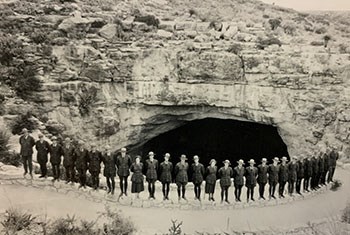
The 1930s was a transitional decade for the NPS uniform as exemptions were granted to women allowing them to wear skirts rather than the standard uniform breeches. Exactly when skirts were introduced is not clear.
The draft 1927 uniform regulations suggested that women’s clothing “…shall be as nearly as practicable that specified for male employees.”. As written, it certainly would have opened the door to the possibility of skirts as part of the standard uniform at some locations. Although that interpretation is speculative, the language of the draft regulations demonstrates that the uniform regulations still applied to women and that the intent was to have the same “look” for men and women.
When the new uniform standards were issued in 1928, the specific references to women were left out, and there were no references to skirts. Riding breeches were still specified for the standard uniform. However, the director’s and superintendent’s authority to exempt specific positions from uniforms and to approve local changes to the uniform were included for the first time.
One superintendent who was quick to exercise his authority in this matter was George B. Dorr at Acadia. In June 1928, he wrote to Acting Assistant Director Arthur E. Demaray about the uniform his secretary, Grace M. Oakes, wore. He noted that although chief clerks and clerk-typists were not required to wear the uniform, “it is a help when she represents me, or the office, in meeting and advising park visitors.” Oakes began working at Acadia in 1920, and 1928 may not be the first year she wore a uniform. As early as 1922 she was giving lectures to community groups and undertaking public relations tasks, similar to those that Dorr describes in 1928. Unfortunately, his letter doesn’t say if her uniform included breeches or a skirt. No photographs of her in uniform have been found. If she wore a skirt in 1928, she was certainly one of the first to do so.
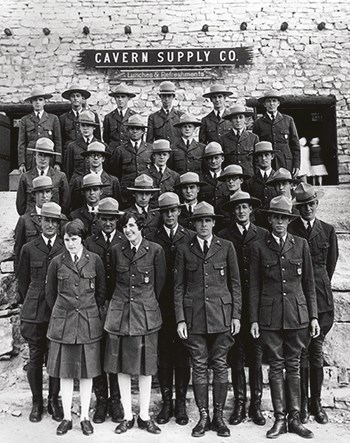
Complete uniform regulations for the early 1930s have not been found, adding to the difficulty of teasing out the timeline. However, the complete 1936 regulations don’t mention skirts either. Although not mentioned in surviving copies of regulations, skirts were certainly accepted as part of the NPS uniform. At the very least, they were a local option under superintendents’ discretion.
A Bit of Skirt
Photographs reveal women wearing skirts with the standard NPS uniform at Carlsbad Caverns National Park in 1930.
A photograph from one of the 1930 superintendent’s monthly reports features that year’s park ranger-guides. The staff are the same as those in this photo (to the right) but in seated positions. The caption in the report notes, “The two ‘guidesses’ are in reality first aid nurses.” That cringe-worthy title was used in park reports and at least one newspaper article from 1930 to 1932 but, fortunately, it seems to have gone out of use quickly.
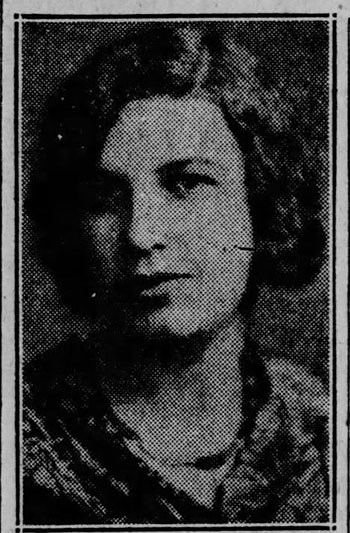
Although the women in the photo are not identified, one of them could be Frances Mildred Rister. She was one of three NPS guides who worked at the park in 1929, but no photographs from that year have been found. A student working her way through school with summer jobs at the park, Rister’s story was featured in several newspaper articles in 1930. Although she mentions women fainting so that they can be carried out of the caverns rather than walking, she doesn’t mention first aid as one of her duties. She wasn’t studying nursing at the College of Mines. Instead, she described the guiding test, physical examination, “strong legs” necessary to be a guide at that site, and the 15-pound lantern and heavy flashlight she had to carry. This casts doubt on her position being that of a first aid nurse rather than guide.
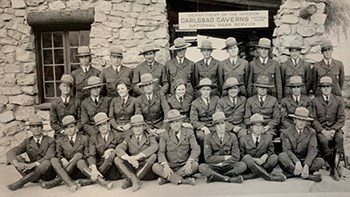
The earliest document referencing skirts found in the NPS History Collection is from March 2, 1932. At the time, the NPS was considering establishing a uniform contract with one vendor to improve uniform color and quality consistency. Superintendent Preston P. Patraw at Zion National Park canvassed his employees, and his anticipated uniform needs under a contract included one “ladies coat & skirt.” The reference to the “ladies coat” likely refers to modifications to the standard uniform coat for size and with the buttons sewn onto the left side rather than the right. Several photographs from the 1930s show women wearing this modified coat. Without additional documentation, all that can be said for sure is that the some NPS superintendents allowed skirts as an option for the standard uniform beginning around 1930.
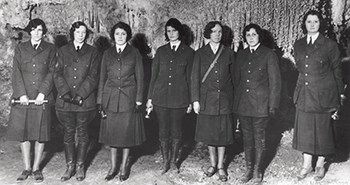
An Evolving Look
Women like Polly Mead and Herma Baggley continued to wear riding breeches until they left their naturalist positions in the early 1930s. However, as the decade marched on, skirts appear to be favored over breeches.
In at least two parks during this transitional decade, different women wore either pants or skirts even though they worked at the park at the same time. One such place was Carlsbad Caverns in 1932. One photo from May of that year shows three women wearing breeches and four wearing skirts. Although the difference might be personal preference, it’s also possible that it reflects the difference between women hired as rangers versus guides, as the woman standing second from the left has a ranger sleeve brassard on the right arm of her coat. Unfortunately, the women’s names aren’t recorded, and no additional information is available at this time. It remains an intriguing possibility.

A Girl Should Be a Girl
Mesa Verde National Park is another site where women working at the same time chose to wear different uniform components. Caroline Huston Thompson probably wore a skirt as a museum assistant in 1932. However, archeologist Virginia H. Sutton, who worked the summers of 1935–1936, wore pants, while museum aide Betty Yelm, wore skirts at the same time. Yelm remembered wearing a skirt while giving tours at Balcony House at Mesa Verde from 1934 to 1939. Although it involved climbing ladders, she stated that the design of the skirt’s pleats kept it down at the back, and “it never worried me.” She also recalled that the skirt was made of NPS material.
Yelm “thought of wearing trousers but they suggested I not do it. I probably could have talked them into it, but I didn’t think it was necessary. I didn’t mind having a feminine role that way.” As she recalled in 1978, “It was still ‘a girl should be a girl.’”
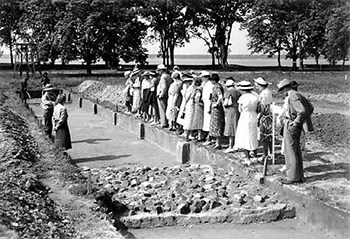
In contrast, she recalls that Sutton, who wore pants, “didn’t want [to wear the skirt]. She wanted to be one of the boys, I think. She did very well at it too.” Yelm’s recollections demonstrate that women probably had more choice in what they wore than was previously believed.
Sutton transferred to Colonial National Historical Park in 1937, initially as a seasonal ranger-historian at Jamestown, where she did wear the skirt as part of her uniform. At Colonial, she became the first woman ranger-historian in the NPS. In December 1937, she received a permanent appointment as the park’s junior archeologist. The next year she was promoted to a permanent assistant research technician. Also in 1938, she married Jean Harrington, an archeologist who became known as the father of modern historical archeology. Although she probably wore “street clothes” when excavating or working behind the scenes, photos show that while giving public tours at Jamestown she wore a skirt with her uniform. Although she resigned from the NPS in 1939, both Harringtons excavated several NPS sites. They were also helped establish the Eastern National Parks and Monuments Association.
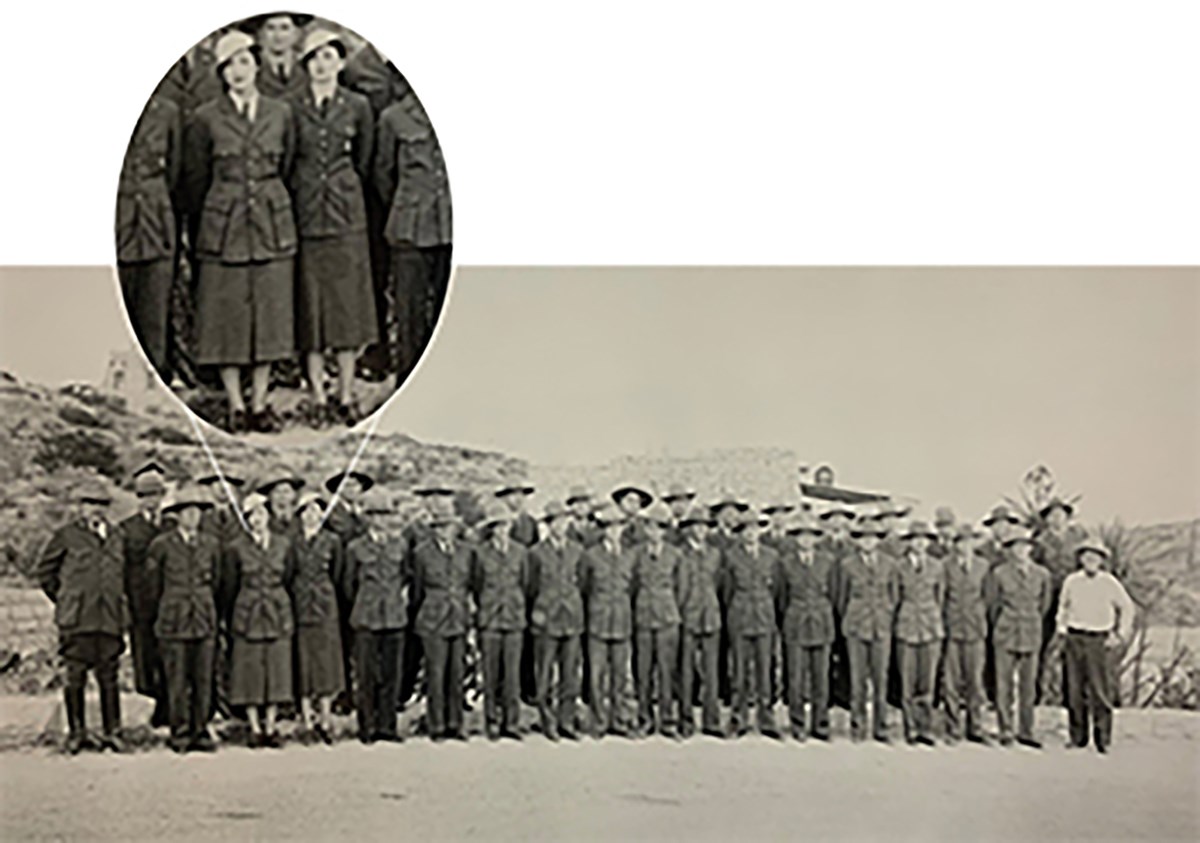
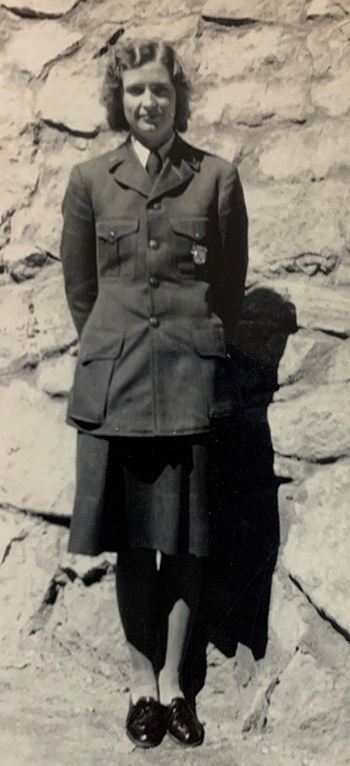
Feminine Fashion
Knowing exactly when skirts became an option for the standard uniform is perhaps less important than knowing why. There are likely several reasons why skirts became the popular choice during the 1930s. As women were largely excluded from ranger and ranger-naturalist positions in late 1920s and early 1930s, parks like Yellowstone and Grand Canyon only hired women as secretaries, clerks, telephone operators, and similar jobs that didn’t include wearing the NPS uniform. Those who got uniformed positions at places like Carlsbad Caverns and Mesa Verde national parks didn’t ride horses or undertake other duties that made skirts so impractical. Where their jobs required more outdoor work, pants were still worn by some women.
Social norms and women’s fashion were also factors. Women’s clothing in the United States during the 1930s featured more skirts or dresses than trousers. Both men and women considered them more feminine. Cost (it was the Great Depression, after all) was also important. Skirts were cheaper to make and could often be made by the women themselves or by others locally using the approved fabric, saving money while providing a better fit. Of course, superintendents still decided which positions to uniform in their parks (and if positions involved skirts or trousers), but some women could choose which they wore. As the 1940s dawned, skirts replaced pants everywhere and women began advocating for better-fitting, more practical—and, yes, more feminine—uniforms.
Explore More!
To learn more about Women and the NPS Uniform, visit Dressing the Part: A Portfolio of Women's History in the NPS.
